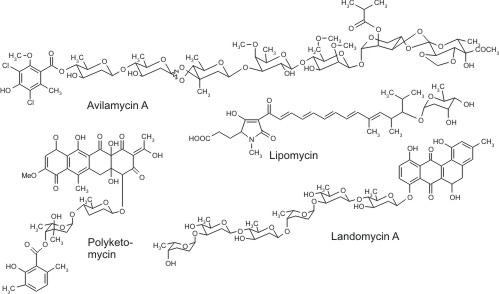P1
Andreas Bechthold
Saccharide antibiotics in Streptomycetes
Actinomycetes and especially Stretomycetes produce a large number of important secondary metabolites. Especially carbohydrate-containing metabolites show many different biological activities and are of great interest. Compounds important for these studies are given in Figure 1.
Figure 1: Structures of selected compounds
D-glucose-1-phosphate is the starting material for the biosynthesis of nearly all sugars as components of natural products produced by Streptomyces strains and as most strains can not use sucrose as carbon source D-glucose has to be added to production media. The multistep conversion of glucose-1-phosphate to different sugars always includes one key step, the conversion of glucose-1-phosphate to a nucleotide activated D-glucose (mostly dTDP-D-glucose) catalyzed by a NDP-D-glucose synthetase (Méndez et al., 2007). Deletion of a gene which is encoding a NDP-glucose synthetase and which is located in a biosynthetic gene cluster, in most cases, leads to the production of non glycosylated products.
Once an antibiotic is produced it is transported out of the cell by drug efflux proteins. In antibiotic producers different types of transporters exist. In several cases two genes encoding an ATP-binding protein and an ABC transporter are responsible for antibiotic efflux, in other cases proton-gradient-dependent transporters (antiporters) are transporting the active drugs out of the cell.
In our projects we are investigating how precursors for the biosynthesis are provided and how the biosynthesis of natural products and the transport of these compounds are controlled. We are focusing on processes which are connected to the membranes of the producer strains.
